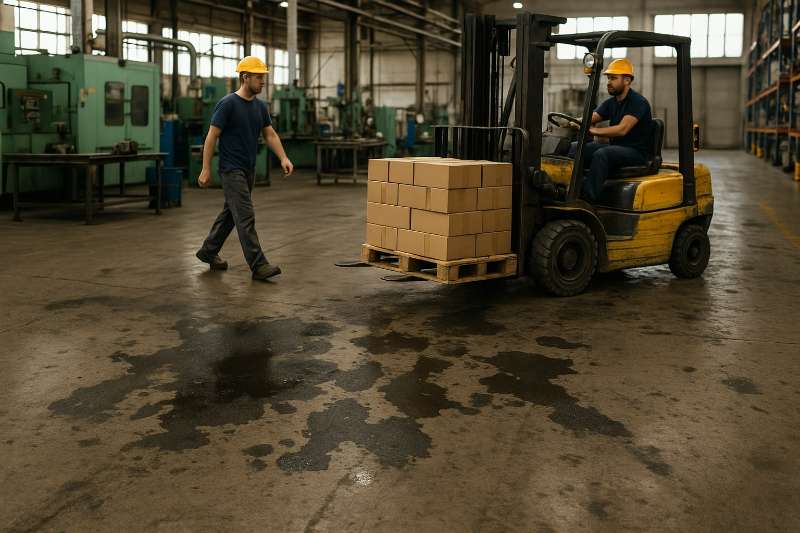Oil stain removal on concrete surfaces requires precision, timing, and the right cleaning approach. Whether on a residential driveway or an industrial floor, oil can penetrate deep into concrete pores, leaving stubborn marks that compromise both appearance and safety. This article provides expert strategies for effective oil stain removal concrete cleaning, from quick absorption methods to professional-grade pressure washing, ensuring durable, stain-free results for commercial and industrial spaces.
Understanding Oil Stains on Concrete
Oil stains on concrete are common in car parks, driveways, and industrial floors. They occur when engine oil, hydraulic fluids, or grease penetrate the porous surface, leaving dark patches that are difficult to remove. Without proper factory cleaning treatment, these stains can cause permanent discolouration, surface deterioration, and increased safety hazard.
Step 1: Act Quickly Before Oil Soaks In
The first step to oil stain removal concrete is to act quickly. this is because the longer oil sits, the deeper it penetrates. For fresh spills, use absorbent materials such as cat litter, sawdust, or baking soda to draw out surface oil. Allow it to sit for several hours before sweeping it away.
Step 2: Degrease and Scrub the Area
Apply a heavy-duty degreaser formulated for concrete surfaces. Spread the product evenly and let it dwell for at least 10–15 minutes. Scrub the area with a stiff-bristle brush to break down the oil residue. Avoid metal brushes that can scratch the surface.
Step 3: Use Hot Water and Detergent
Rinse with hot water mixed with a pH-neutral detergent to emulsify remaining oil. This step helps lift residual grease and prevents film formation. Pressure washing enhances results on commercial and industrial sites.
Step 4: Apply a Poultice for Deep Stains
For older, embedded stains, mix a poultice of baking soda and acetone to create a paste. Apply it over the stain, cover with plastic wrap, and let it dry for 24–48 hours. Once removed, rinse thoroughly. This method pulls oil trapped within the pores of the concrete.
Step 5: Consider Pressure Washing
High-pressure cleaning is effective for large or heavily stained surfaces. Professional-grade pressure washers remove both surface oil and embedded grime. For businesses, scheduling regular pressure washing helps maintain a clean, safe environment.
Step 6: Seal the Concrete to Prevent Future Stains
After cleaning, sealing the surface is essential. Concrete sealers create a barrier that prevents oil and other contaminants from soaking in. Choose an industrial-grade sealer suitable for outdoor or high-traffic areas.
Additional Maintenance Tips
To maintain a clean and stain-free concrete surface, regular care is essential. Minor oil drips should be cleaned weekly to prevent them from seeping into the concrete and creating long-term marks. In high-risk areas such as factory entrances, loading docks, or car parks, absorbent mats or drip trays can be used to capture spills before they spread. Routine inspections help detect early signs of discolouration or wear, allowing for prompt cleaning before stains set in. Periodically resealing the surface enhances protection, preventing oil and contaminants from penetrating the concrete. Consistent upkeep extends the lifespan of the surface and reduces the need for intensive restoration.
Professional Concrete Cleaning in Melbourne
SM&MN Commercial Cleaning Experts deliver industrial-grade concrete cleaning and oil stain removal services throughout Dandenong South and Greater Melbourne. Using advanced equipment and eco-friendly cleaning solutions, the team restores and protects concrete surfaces for warehouses, factories, and commercial properties.
For professional results and guaranteed value, contact SM&MN Commercial Cleaning Experts today at 1300 142 715 or email [email protected]. You can also visit the official website to request a free quote. SM&MN guarantees competitive pricing and will beat any written quote by 5%, providing superior and cheaper concrete cleaning service and savings across Melbourne.
Conclusion
Effective oil stain removal on concrete relies on understanding the nature of the stain, applying the right cleaning method, and maintaining protective measures over time. Understanding oil stains on concrete establishes how oil penetrates and binds to the surface, which highlights the importance of quick and targeted action. Beginning to act quickly before oil soaks in helps prevent deep staining, while degreasing and scrubbing the area and using hot water and detergent provide the foundation for removing surface contaminants. More persistent marks benefit from techniques like applying a poultice for deep stains and broader treatments like pressure washing that restore large concrete areas efficiently. finishing with seal the concrete to prevent future stains and applying the recommendations in additional maintenance tips ensures long-term protection and durability. Together, these steps form a complete, practical framework for maintaining clean and professional concrete surfaces in Melbourne's residential, commercial, and industrial environments.



































